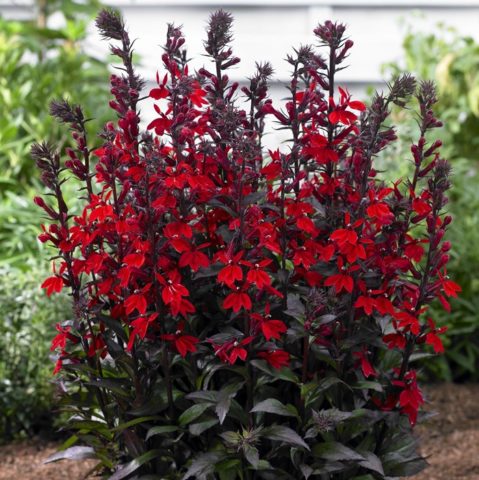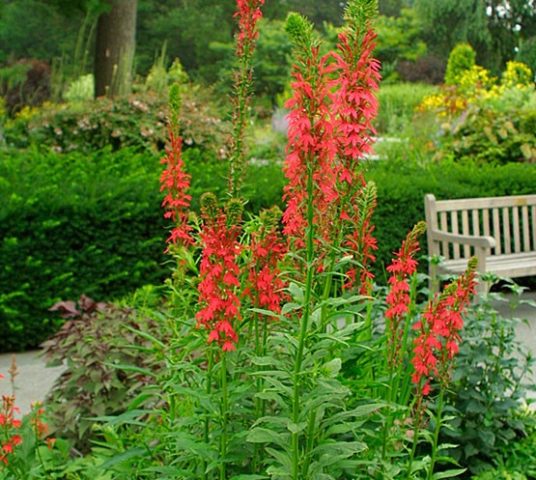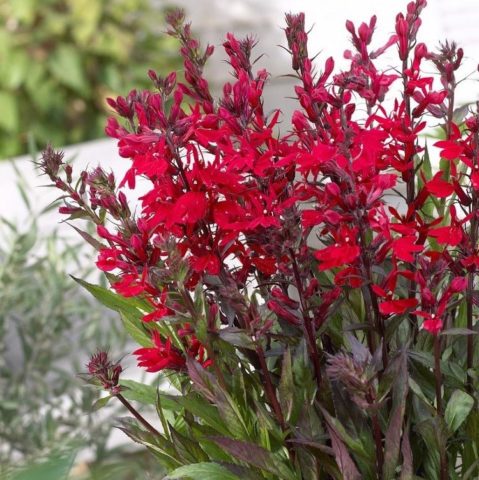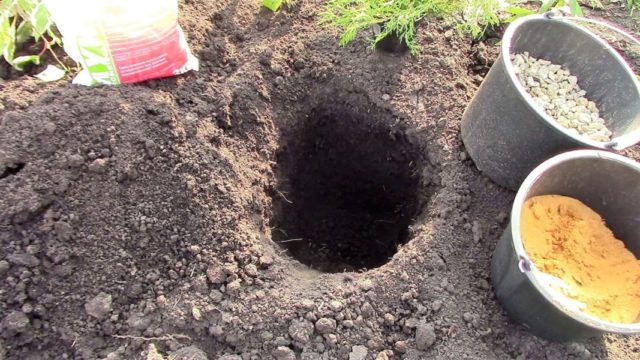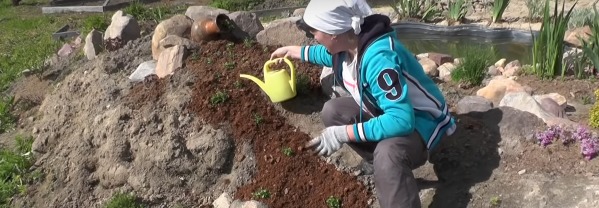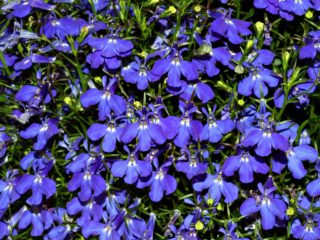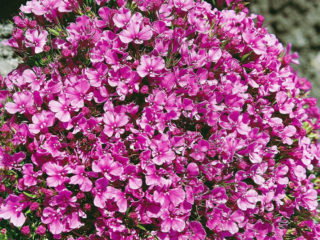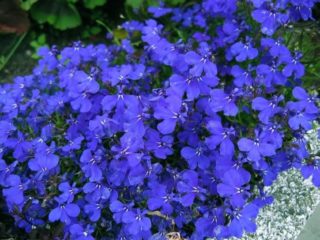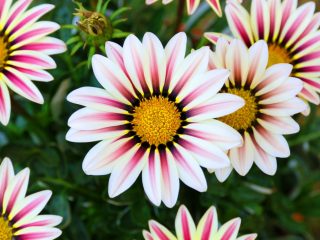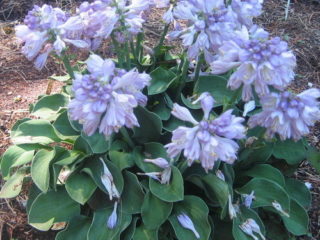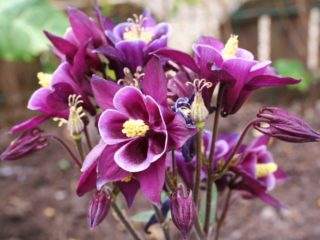Content
Lobelia purpurea or cardinal is a flowering plant that takes root well in Russian latitudes. The crop is responsive to regular watering and fertilization and tolerates frost quite well. In its natural environment it is found in the central and eastern states of America.
Description of perennial purple lobelia
Purple lobelia (lobelia cardinalis) is a perennial plant that in natural conditions lives both on the coast and on the water. Therefore, it is successfully grown in gardens, flower beds, and also bred in aquariums. A bush with bright green rounded leaves up to 5 cm wide can reach a height of 50-70 cm; individual specimens of fiery lobelia stretch up to 1 meter.
The stem is erect, no more than 0.3 cm in diameter. May have a red or dark green color.

The inflorescences are racemose, the peduncles are quite tall - up to 50 cm
If the plant takes root under water, the flower stalks always rise above the surface and produce first flowers, and then fruits with seeds. A distinctive feature of purple lobelia is its attractive bright red shades.
Lobelia has other names that emphasize its color and “status”:
- cardinal;
- blood red;
- fiery;
- shiny;
- lobelia purple-red cascading.
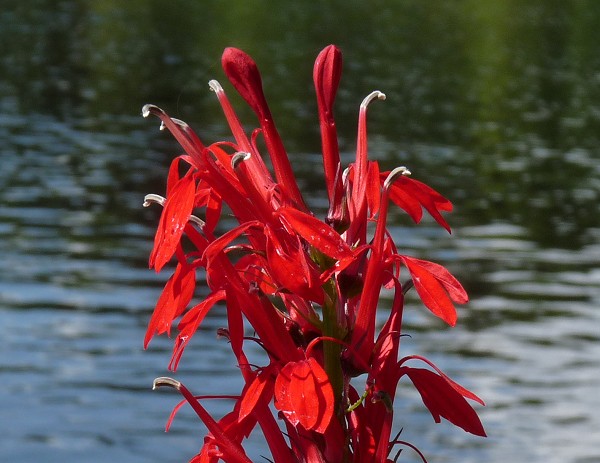
Under natural conditions, the green part of the lobelia can be at the bottom, and the flower stalks rise above the surface
Growing conditions for purple perennial lobelia
Growing lobelia purpurea is not as difficult as it might seem at first glance. Since this is a semi-aquatic plant that can easily grow in an aquarium, it requires certain conditions to be met:
- The site should be completely open, although light shading is also allowed.
- The seedling needs strong soil moisture. It is better to plant the crop on the coast of a body of water, for example, a country pond.
- The plant prefers warm climates. You can transplant seedlings into open ground only in the second half of May or early June.
- The soil composition must include a significant portion of river sand. Thanks to this, it will be possible to create a mixture that in its structure and composition resembles a muddy bottom.
Application in design
Cardinal lobelia (pictured) can become a real center of attraction in the garden. Thanks to its bright color, it can be used in almost any application:
- single landings;
- multi-tiered flower beds;
- in outdoor pots.
Aquarium purple lobelia does not bloom. However, it brightens up the space with its vibrant greenery. Seedlings are placed on the bottom. It is best to root them using decorative small stones of the same color (brown, gray).
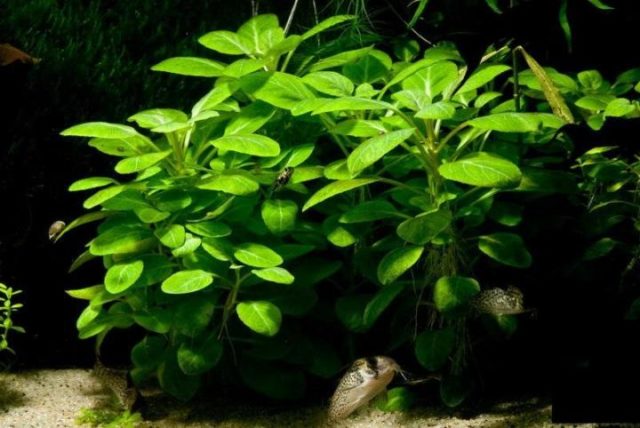
Aquarium lamps are directed so that the rays hit the foliage
In aquarium design, Lobelia cardinalis looks good with other plants.
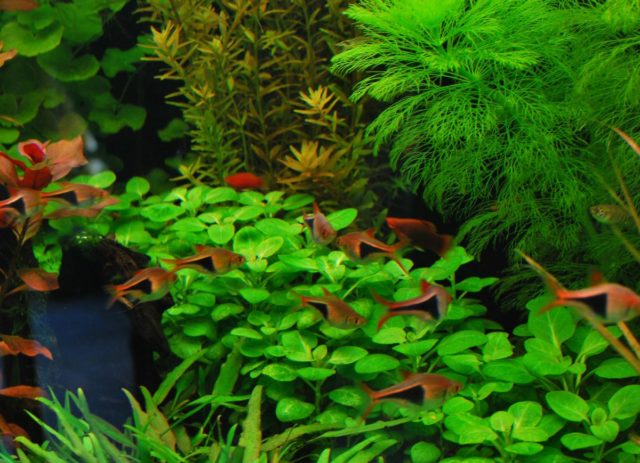
Lobelia cardinalis can be planted in the center or in the foreground, and algae of other shades can be placed on the sides and back
How does cardinal lobelia propagate?
Lobelia can be propagated by cuttings and seeds. In the latter case, it is necessary to grow seedlings. This can be done at home, but special attention should be paid to the soil - it should resemble a muddy bottom.
A simpler method of propagation is cuttings. The stems have many side shoots that can be easily separated. They are characterized by rapid growth, so a new seedling will be obtained in 2-3 months. Cuttings begin in the fall. Sequencing:
- Lobelia purpurea is dug up and stored at home at a temperature of 13-15 ° C, but no more.
- In February, the pot is transferred to normal room conditions.
- At the same moment, the side shoots are removed so that the size of the cuttings is 10-12 cm.
- Make a lower oblique cut and immerse the lobelia purpurea stalk in a solution that stimulates growth.
- Prepare pots with substrate. Mix peat, sand and humus in equal quantities and moisten the soil.
- Root the cuttings at a slight angle.
- Cover with film or glass to create greenhouse conditions. They are periodically opened slightly so that the seedlings do not rot.
- Constantly provide additional lighting (length of daylight hours is at least 12 hours).
The cuttings grow in 2-3 months, after which (at the end of May) they are transferred to open ground.
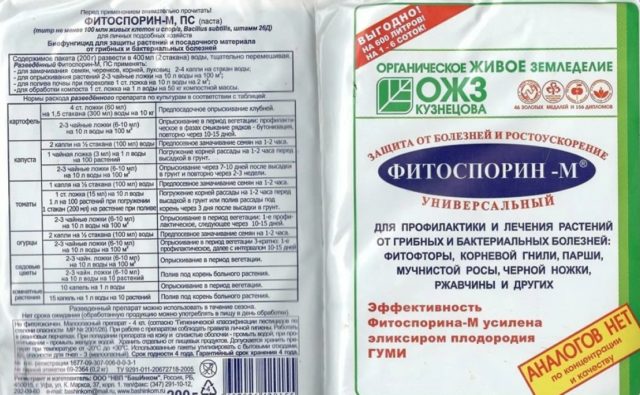
It is recommended to pre-treat the seedlings with any fungicide, for example, Fundazol or Fitosporin
Landing rules
Lobelia purpurea is a heat-loving plant.The crop needs a special type of soil. When growing, it should be taken into account that under normal conditions the bush grows on the coast or almost in water.
Recommended timing
Seedlings obtained from seeds or cuttings are transferred to open ground only at the end of May or even at the beginning of June, when the soil is well warmed up and night temperatures are not lower than 10-12 °C. In the south of Russia it is allowed to transfer seedlings in mid-May, but not earlier. Temperature (especially at night) is of great importance.
Choosing a location, lighting
When choosing a planting area, you should pay attention to several features:
- Garden design - how well lobelia will fit into the landscape.
- Openness - the area should be well lit by the sun throughout the day.
- Good moisture – it is optimal to plant purple lobelia on the coast of a body of water (for example, near a country pond) or in lowlands. At the same time, the bush does not tolerate stagnant moisture, so it is necessary to prevent waterlogging.
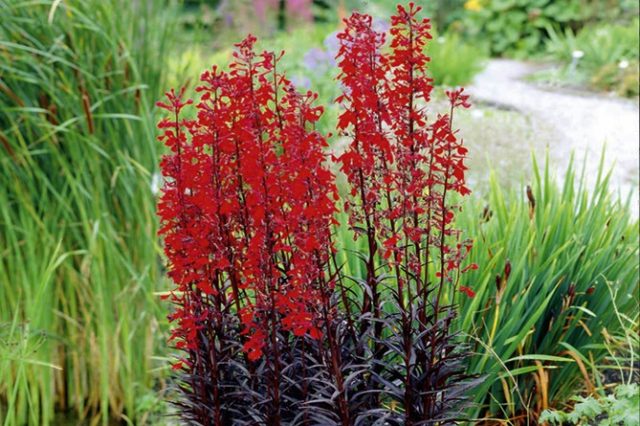
To plant lobelia purpurea, choose the most prominent place in the garden.
Soil preparation
Despite the fact that purple lobelia prefers a special soil, it is easy to make at home. The following components will be required:
- clean river sand;
- peat;
- humus.
The optimal ratio is 1:1:2. To plant lobelia, drainage is prepared in advance - broken brick, small pebbles, expanded clay.
How to plant purple lobelia correctly
In order for the plant not only to take root, but also to bloom, you need to know the rules of planting. Experienced gardeners recommend following this algorithm:
- The area is thoroughly cleaned and dug up.
- Several holes of small depth up to 25-30 cm are formed.
- Fill with a drainage layer of 5-7 cm.
- 4-5 seedlings are planted in one hole at once.
- Well moisturizes.
- Cover with a jar or film to ensure greenhouse conditions. The shelter can be kept for several days, periodically removing it for ventilation.
- The soil must be mulched. A layer of spruce branches, peat or hay will retain moisture in the soil and also prevent the rapid development of weeds.Advice! The purple lobelia bush is quite compact, so seedlings can be placed at intervals of 25 cm. However, if you want the plantings to look more free, it is advisable to increase the distance to 35 cm.
Features of caring for seedlings
Since lobelia purpurea is a full-fledged species and not a hybrid, it can be grown from seeds. They are collected at the end of August. To do this, cut off the seed pods and grind the shell. The seeds are placed in bags made of natural fabric and stored in the refrigerator until the next season (maximum 4 years). Sowing of seedlings is carried out at the end of February or early March.
The rules for planting and caring for seedlings are generally simple, but there are some peculiarities:
- A mixture of sand, peat and humus (ratio 1:1:2) is used as soil.
- The soil is poured into containers and well moistened with a spray bottle.
- Purple lobelia seeds are distributed on the surface - there is no need to bury them.
- They are first grown under film or glass at a temperature of 22-24 °C.
- Constantly illuminated with a phytolamp. The duration of daylight should be at least 10 hours.
- The greenhouse is ventilated periodically. The glass is removed 2 weeks after planting.
- Continue to grow at room temperature (20-22 °C).
- A month after planting, the seedlings peak, i.e. seated. Containers are chosen 1.5-2 times larger in diameter.
- Then, 2 weeks before planting, the seedlings are hardened at a temperature of 14-15 °C.
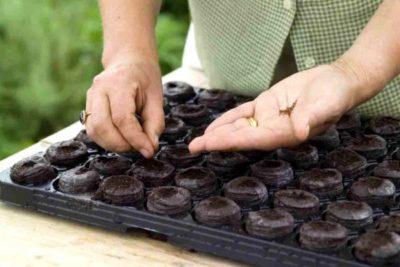
Peat pots or other small containers can be used to plant purple lobelia seeds.
Rules for caring for cardinal lobelia
The rules for caring for Lobelia purpurea vary significantly depending on the environment. If it grows in open ground, agricultural technology will be more difficult than in the case of an aquarium. The bushes must be provided with regular watering, fertilizing and plenty of light.
In the open ground
Lobelia purpurea is very sensitive to even the slightest lack of moisture. Do not allow the soil to dry out, much less crack. Watering is always plentiful - a bucket per 1 m2. During drought it is necessary to organize drip irrigation.
Fertilizing is applied several times per season:
- nitrogen supplements - in April or immediately after transplanting seedlings into open ground;
- as soon as the buds have formed, superphosphates and potassium salt are added, a similar composition is added at the flowering stage of lobelia purpurea (with an interval of 15 days);
- The last time feeding is given is in mid-August.
The purple lobelia bush needs shaping. Therefore, during the period of active growth, the upper shoots should be pinched so that the plant produces lateral branches.
Preparing for winter
Lobelia purpurea is characterized by an average degree of winter hardiness. In almost all regions (except the southern ones), the plant should be prepared for the winter:
- If the region has severe winters down to -25 °C and below, the bush must be dug up and sent to overwinter in pots at home (not higher than +10 °C). The optimal storage location is the basement.
- If winters are not too frosty, you can leave the seedlings in open ground. In this case, the branches are cut almost to the height of the stumps (no more than 3-4 cm in height). Next, the lobelia is covered with a layer of dry leaves (20 cm).
In water
Lobelia purpurea is much easier to care for in water. Usually it is planted along the side walls and rooted in rocky soil. Standard conditions of detention:
- temperature 22-25 °C;
- the reaction of the environment is neutral;
- water hardness within 5-15;
- the lighting is bright and long-lasting (from 10 hours a day).
In such conditions, lobelia develops very quickly and soon produces flower stalks that can form purple flowers above the surface of the water. To prevent this from happening, the tops must be pinched before they reach the surface.
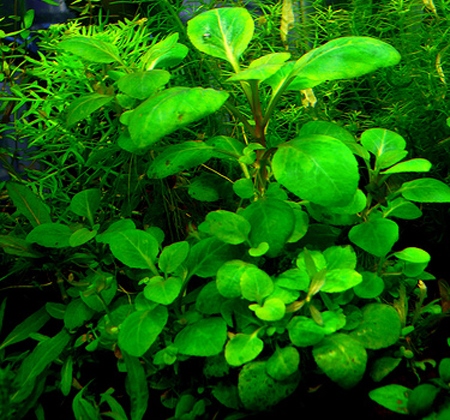
In the presence of stable lighting, purple lobelia grows very quickly
Pests and diseases
Purple lobelia is resistant to many diseases, including root rot, as it can grow reliably even in water. However, its foliage and stems are often affected by a fungal infection - powdery mildew. Slugs can also actively feed on greens.
You can learn about the first signs of powdery mildew on the leaves of purple lobelia by the characteristic whitish coating. At the first stages, it is possible to save the culture. To do this, just spray the cardinal lobelia with any fungicide:
- Bordeaux mixture;
- Tattu;
- Speed;
- Topaz and others.
As for slugs, it is easier to destroy them manually. Any insecticides or other drugs are unlikely to help. However, it is still possible to overcome the invasion of these small mollusks. To do this, stone chips and small eggshells are poured around the purple lobelia bushes, and the side of a broken ceramic pot is placed.

Eggshells, pine needles, as well as ready-made Predator bait will help get rid of slugs in the area
A rough surface will interfere with the movement of slugs, which will prevent them from gaining access to the plant itself.
Conclusion
Lobelia purpurea is one of the most vibrant and attractive flowers in the garden. Both experienced and novice gardeners can grow a cardinal bush. If there is a pond on the site, the seedlings will decorate not only its banks, but also the surface of the water.
